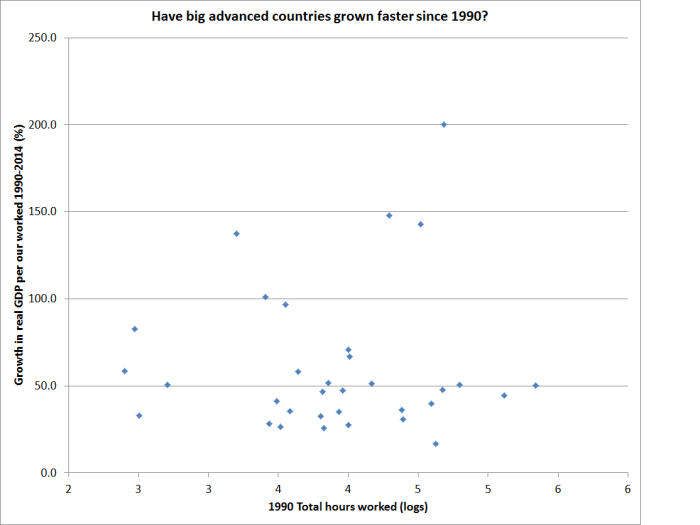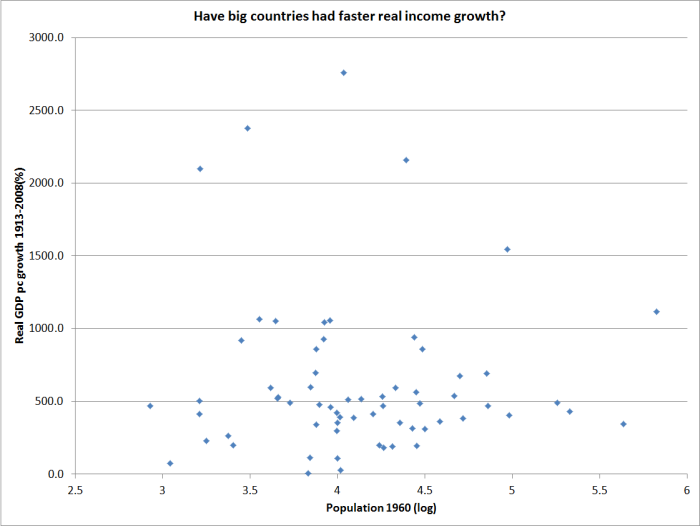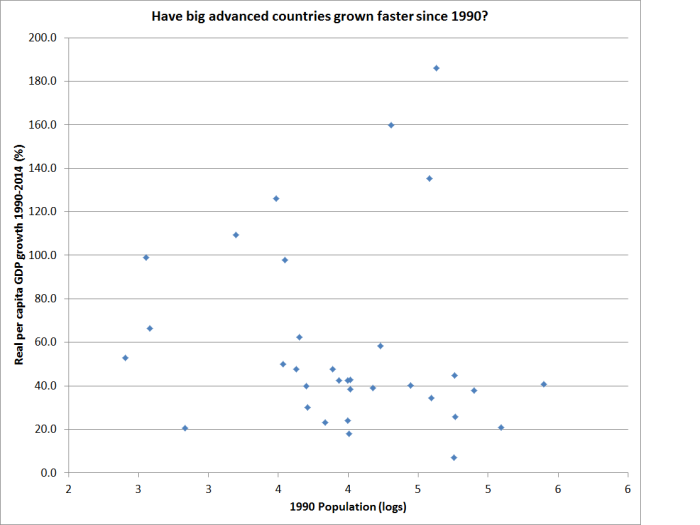Implicit in much of the discussion around an appropriate immigration policy for New Zealand is a sense that our prospects would be better if only New Zealand had more people. Some have come out and actively argued the case – see, for example, this brief note from the NZIER last year.
I’ve long been fairly sceptical of that proposition. A casual glance around the world suggests no very obvious relationship. The United States and Iceland co-exist, and Japan and Singapore. At the other ends of the income spectrum, India and Bhutan, and Brazil and Costa Rica. There are all sorts of arguments advanced around the economics of agglomeration, and that analysis seems to work quite well in describing what happens within countries. But it does much less well in describing economic performance across countries. And as I’ve pointed out to people previously, if the real economic opportunities in big countries were so much superior to those in small countries, large countries would tend to have (more high-yielding projects and) higher real interest rates than small countries. But they don’t.
Angus Maddison put together the most widely-used longer-term estimates of GDP per capita for a wide range of countries. There are plenty of holes that can be poked in those estimates, but they are what we have. He produced estimates for a large number of countries for 1913, just before the disruption and destruction of World War One, and as he died a few years ago his last numbers were for 2008.
This chart shows per capita real GDP growth from 1913 to 2008 for the sixty or so countries Maddison had estimates for, plotted against the level of the population of each country in 1960 (roughly half way through his period).
There is no relationship. And there is also no relationship if:
- We take out the countries that had exceptionally fast growth over that 95 year period, or
- If we restrict the sample to a group of countries that were already fairly advanced in 1913 (Western Europe, and the Anglo offshoot countries). The United States and Switzerland, for example, had almost identical real per capita GDP growth over that period.
What about more recent periods? The Conference Board has built on Maddison’s work and has estimates for a wider range of variables for more recent decades. One argument – advanced in a New Zealand context by Phil McCann – is that size has become a much more important issue for advanced countries in the last few decades. If so, perhaps we might have expected to see big countries growing faster than small countries over that period.
Here are two charts that look at that relationship for 33 advanced economies.
The first shows the relationship between the (logged) level of population in 1990 and growth in real per capita GDP growth since 1990.
And the second shows the relationship between the (logged) level of total hours worked in 1990 and growth in real GDP per hour worked since 1990.

In neither case, is there any sign of a positive relationship.
Charts of this sort are, of course, not conclusive. Lots of other things are going on in each country. In an ideal world, one would want a much fuller and formal modelling of the determinants of growth. But equally, the absence of a positive relationship between the size of the country and its subsequent growth shouldn’t be surprising, and there have been previous formal research results suggesting a negative relationship.
Of course, perhaps New Zealand is an exception. Perhaps real per capita incomes would really be materially lifted if we had many more people here, even though there has been no such relationship across the wider range of advanced countries in history. But in a sense we have been trying that strategy for 100 years and there is no sign that it has worked so far. Very few relatively advanced countries have had weaker real per capita growth than New Zealand in the last 100 years (only places like Argentina and Rumania).
Perhaps the next 25 or 100 years would be different. But I think the onus is now on the advocates of policies to bring about a bigger and more populous New Zealand to demonstrate where and how the gains to New Zealanders from a much larger population are occurring? Recall that all our population growth now is resulting from government policy choices – the level of non-citizen immigration that the New Zealand government is targeting. If population growth were being driven by the private choices of New Zealanders (higher birth rates, or a permanent reversal of the New Zealand diaspora), I wouldn’t regard it as a particular matter of policy interest. But when our governments are actively targeting a larger population the onus is surely on them to demonstrate the real economic gains to New Zealanders. 25 years on in the current strategy there is no sign of them yet.
One could make a case that New Zealand’s greatest asset is the fertile land and temperate climate. Refrigeration and much reduced shipping costs in the late 19th century gave those natural resources real economic value. But there has been no comparable “shock” for the last hundred years, and arguably we are simply spreading those natural resource “rents” over more and more people. Norway would be unlikely to have the highest real GDP per capita in Europe if they had responded to the discovery of vast oil and gas resources by doubling their population.
Natural resources alone don’t make a country rich (see Iran or Zambia), and natural resources aren’t the only way to get rich (see Singapore or Taiwan) but for a very isolated country they may well, in conjunction with strong institutions and competitive markets, provide the best possible basis for re-establishing top tier living standards for a small population. So far, adding lots more people doesn’t seem to have helped.
Talking of which, it is now 21 August and there is still no sign of an MBIE response to my 28 May request for copies of advice to ministers on the economic impact of immigration, and on the permanent residence approvals target.


“But when our governments are actively targeting a larger population the onus is surely on them to demonstrate the real economic gains to New Zealanders. 25 years on in the current strategy there is no sign of them yet. ”
Why is the default position assumed to be no immigration, and then the government must justify allowing some immigration?
Couldn’t the default position be open borders, and the government must justify restricting immigration?
LikeLike
I think mainly because open borders effectively gives up any conception of a nation/nationhood, and I don’t sense that any country has been willing to do that.
And since the law is the anyone coming in needs govt approval, someone needs to decide how many (or at least which criterion). If we – NZ voters – are making laws, it seems reasonable that we would seek to do so to maximise our own welfare. In principle, our welfare might be enhanced by a humanitarian perspective (allow in lots of refugees on compassionate grounds) or even by the economic gains to the migrants themselves, but NZ govts have sold the policy for 25 years largely on economic benefits to NZers.
LikeLike
750 refugees a year is not a very large number. Immigration policy for real PLT is replacement. The 100,000 new migrants and net 60,000 includes net gains in international student arrivals, foreign workers rebuilding Chch and tourists. NZ population growth is largely from natural birth. NZ does not have a migrant problem. It is a Auckland problem largely due to a single international airport where Auckland captures most of the new migrants coming in to replace the kiwis that depart.
LikeLike
We can debate the costs and benefits of immigration, but the population numbers are pretty clear. The average annual outflow of NZers now slightly exceeds the shrinking annual rate of natural increase. That means that withouth non-citizen immigration we’d have a flat or slightly falling population.
https://croakingcassandra.com/2015/06/23/immigration-policy-106-per-cent-of-net-new-housing-demand/
Again, reasonable people can differ on whether that is good, bad or indifferent
(and what the limits of the PLT numbers themselves)
https://croakingcassandra.com/2015/07/13/just-how-large-a-contribution-has-net-migration-made-to-population-growth/
LikeLike
Hi Michael – I’m not sure if you’re familiar with Martin Armstrong (http://www.armstrongeconomics.com/armstrong_economics_blog). If not, I would strongly suggest that you read his writings, which I have found invaluable, and I’m sure will be of interest to you. His commentaries on this, from an historical perspective, state that a country’s wealth is a result of the total productivity of the people. Many have equated more land/conquests and more gold/resources with greater “wealth”. Putting aside one’s perception of “wealth”, if this were so then Russia would be wealthier than Japan and Germany, etc. Spain once held the most gold through conquests and was insolvent soon after. Personally, I prefer to avoid the nationalistic tones that this kind of debate brings, as – like many – I am the product of immigrants and I see myself as both a Kiwi and a citizen of the world in equal measure. I don’t feel that anyone has more of a right to a country than anyone else and we should ideally be based on a meritocracy (wishful thinking).
LikeLike
Thanks Len
I’ll take a look. Seems to me that ideas/innovation/knowledge are at the heart of prosperity, and sustained improvements in it. But abundant natural resources – to which ideas and technology can be applied – make a difference too. NZ didn’t have one of the highest GDP per capitas in the world in 1913 simply because it had natural resources – physical NZ was much the same as it had been several hundred years before – but because ideas, technologies etc were applied to make them valuable. And steadily better ideas and technologies have been applied over the subsequent years to produce eg higher lambing percentages, or to identify products that use the soil and climate in a higher value way.
Michael
LikeLike
Thanks for writing this up, Michael.
You said: “There are all sorts of arguments advanced around the economics of agglomeration, and that analysis seems to work quite well in describing what happens within countries. But it does much less well in describing economic performance across countries.”
Don’t you find this a little strange, though? That the mechanism works at one level, but not at another. The thought that jumps out at me is that relative institutional arrangements are not important at the city/region/state level (as cities/regions/states share the same national laws, and similar cultures, etc), but are important at the country level (as countries don’t often share the same laws, and are often very culturally different).
The fact that the raw correlation isn’t there in the data might be a sign that even after controlling for other factors, the effect of population on growth is not large (perhaps population density is different, though…). However, I think you need to do more here to make the argument convincing. Perhaps you could point to the papers you’ve seen on this, and explain why you think population is not important for country growth and yet is important for city/region growth.
(Of course, perhaps even at the city/region level, the effect of population is not strong, and really its a bit of a red herring. Still, that would be something worth knowing).
LikeLike
Thanks James
Yes, in some ways it does seem odd. I’m not sure I’ve seen papers trying to tackle the agglomeration issue in a cross-country sense, altho I should go back and look at some of the papers Phil McCann used to point to around Europe. In some ways – given labour and trade mobility, and mostly a single currency – it is even more surprising that there is no obvious link between size and growth even within the continental European group of countries. Of course, there is something there – the OECD have highlighted that Belgium has GDP pc a lot higher than say its regulatory structures etc seem to warrant, and location must be part of that. But location is the one thing we can’t do anything about, and I don’t doubt it is important.
MIchael
LikeLike
Cross-country agglomeration, isolation etc. are things that I think are relevant, although I have no evidence. NZ must be the most isolated OECD country? I feel that NZs isolation makes things it harder for a NZ company to take on the world from NZ, whereas an LA company or a Belgian company can probably feel more confident trying their luck in SF or Holland.
As a similarly isolated OECD area, I wonder how Western Australia would go if it didn’t have minerals?
I wonder what NZ would be like with a population of 50-100m?
LikeLike
Yes, I agree that location is a constraint. Question is how best to overcome that. I suggested a few weeks ago that NZ’s “optimal” population might be 2m or 200m, my real point being that the difference between say 5m and 8m was unlikely to be material in overcoming any locational or size advantages (while still depleting natural resource rents). To me the question is one of whether we can better achieve high first-world incomes by playing to our natural resource strengths with, say 4m people (for which we still need open markets, innovation etc) or to, in effect, turn the country into another country altogether. After all, a NZ of 50m people would not be New Zealand in any sense that we’ve known it for the last 150 years.
ps, I notice that W Australia’s population (with all those resources) is not much more than half ours.
LikeLike